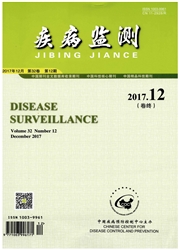

 中文摘要:
中文摘要:
目的监测2013年云南省肾综合征出血热(HFRS)人间疫情和宿主动物,分析流行病学特点,为制定防治策略提供科学依据。方法居民区用鼠笼法、野外用鼠夹法,进行鼠密度监测,采集人血清以及宿主动物肺脏组织,用免疫荧光法进行汉坦病毒(HV)抗原或抗体检查,采用Spss 17.0软件分析数据。结果 2013年云南省共报告HFRS病例95例,其中实验室诊断81例,临床诊断14例,发病率0.20/10万; 发病季节以5月和12月为主,发病人群以中老年男性农民为主; 泸西县、祥云县和大姚县3个监测点秋季人群HV阳性率分别为14.15%、16.00%和3.00%,差异有统计学意义(χ2=8.37,P〈0.05); 3个监测点共捕获12种424只小兽,其中居民区褐家鼠为优势鼠种,野外大绒鼠和高山姬鼠为优势鼠种,宿主动物HV阳性率为13.21%(56/424),阳性宿主动物为褐家鼠、黄胸鼠、大绒鼠、高山姬鼠、中华姬鼠、锡金小鼠、短尾鼩和灰麝鼩。结论滇西地区为HFRS主要发病地区,秋季居民区HFRS的防控更为重要,监测点广泛存在以褐家鼠为主要传染源的家鼠型HFRS疫源地,还存在以高山姬鼠和中华姬鼠为主要传染源的野鼠型HFRS疫源地,食虫动物短尾鼩和灰麝鼩也发现HV感染。
 英文摘要:
英文摘要:
Objective To survey epidemic situation in human and host of hemorrhagic fever with renal syndrome (HFRS) in Yunnan Province in 2013, to analyze the epidemiological characteristic for offering a scientific guidance for prevention and control. Methods Rodent density was monitored with cage in residential areas and clamp in field. Human sera and the lung tissue and sera of rodents in the surveillance counties were collected to detect antibody and antigen of hantavirus (HV) with immunofluorescence method. The data was analyzed by Spss 17.0. Results In 2013, totally 95 HFRS cases were reported, including 81 laboratory diagnosed cases, 14 clinically diagnosed cases, with incidence rate of 0.20/100 000. The highest inci- dence were in May and December, mainly concentrated in male peasants of middle and old age. The recessive infected rates of HV in healthy population of Luxi County, Xiangyun County and Dayao County were 14.15%, 16.00% and 3.00%, respec- tively in Autumn, with statistical difference (χ2=8.37,P〈0.05). There were 424 small mammals of 12 species captured in the three counties, with Rattus norvegicus of the dominant species in the residential areas and Eothenomys miletus and Apodemus chevrieri of the dominant species in the fields. The positive rate of HV was 13.21% in host animals. They were Rattus norveg- icus, Rattus flavipectus, Eothenomys miletus, Apodemus chevrieri, Apodemus draco, Mus pahari, Anourosorex squamipes and Crocidura attenuate. Conclusions HFRS is mainly prevalent in western Yunnan, China. It is very important for HFRS con- trol and prevention in residential areas in autumn. There are Rattus foci of HFRS with the main hosts of Rattus norvegicus and also foci of Apodemus with the main hosts ofApodemus chevrieri and Apodemus draco in monitoring areas. Anourosorex squamipes and Crocidura attenuate are also found infection with HV in Yunnan Province.
 同期刊论文项目
同期刊论文项目
 同项目期刊论文
同项目期刊论文
 期刊信息
期刊信息
